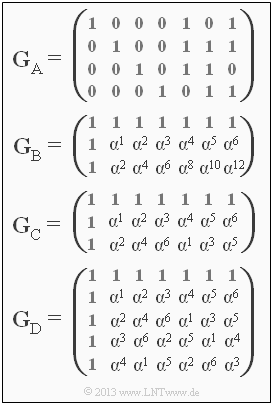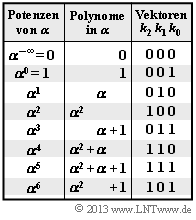Difference between revisions of "Aufgaben:Exercise 2.08: Generator Polynomials for Reed-Solomon"
| Line 44: | Line 44: | ||
===Musterlösung=== | ===Musterlösung=== | ||
{{ML-Kopf}} | {{ML-Kopf}} | ||
| − | '''(1)''' Richtig sind die <u>Lösungsvorschläge 2 und 3</u> ⇒ Matrizen $\mathbf{G}_{\rm B}$ und $\mathbf{G}_{\rm C}$ | + | '''(1)''' Richtig sind die <u>Lösungsvorschläge 2 und 3</u> ⇒ Matrizen $\mathbf{G}_{\rm B}$ und $\mathbf{G}_{\rm C}$. *In der Matrix $\mathbf{G}_{\rm C}$ wurden bereits die erlaubten Umformungen $\alpha^8 = \alpha, \ \alpha^{10} = \alpha^3$ und $\alpha^{12} = \alpha^5$ berücksichtigt. |
| + | *Die Matrix $\mathbf{G}_{\rm A}$ gilt für den $(7, \, 5, \, 3)$–Hamming–Code und $\mathbf{G}_{\rm D}$ gehört zum $\rm RSC \, (7, \, 5, \, 3)_8$. Siehe hierzu Teilaufgabe (3). | ||
| − | '''(2)''' Beim $\rm RSC \, (7, \, 3, \, 5)_8$ werden in jedem Codierschritt $k = 3$ Informationssymbole verarbeitet, im Codierschritt 1 die Symbole $\alpha^4, \ 1$ und $\alpha^3$. Mit der Generatormatrix $\mathbf{G}_{\rm C}$ gilt somit: | + | '''(2)''' Beim $\rm RSC \, (7, \, 3, \, 5)_8$ werden in jedem Codierschritt $k = 3$ Informationssymbole verarbeitet, im Codierschritt 1 entsprechend der Angabe die Symbole $\alpha^4, \ 1$ und $\alpha^3$. |
| + | |||
| + | [[File:P_ID2584__KC_T_2_5_Darstellung.png|right|frame|$\rm GF(2^3)$ in Exponenten–, Polynom- und Koeffizientendarstellung]] | ||
| + | Mit der Generatormatrix $\mathbf{G}_{\rm C}$ gilt somit: | ||
:$$\underline {c} = \underline {u} \cdot { \boldsymbol{\rm G}}_{\rm C} = | :$$\underline {c} = \underline {u} \cdot { \boldsymbol{\rm G}}_{\rm C} = | ||
\begin{pmatrix} | \begin{pmatrix} | ||
| Line 58: | Line 62: | ||
\end{pmatrix}\hspace{0.05cm}. $$ | \end{pmatrix}\hspace{0.05cm}. $$ | ||
| − | + | ||
| − | :$$c_0 \hspace{-0.15cm} \ = \ \hspace{-0.15cm} \alpha^{4}\cdot 1 + 1 \cdot 1 + \alpha^{3}\cdot 1 = | + | Damit ergibt sich entsprechend der nebenstehenden Hilfstabelle: |
| − | + | :$$c_0 \hspace{-0.15cm} \ = \ \hspace{-0.15cm} \alpha^{4}\cdot 1 + 1 \cdot 1 + \alpha^{3}\cdot 1 = | |
(110) + (001) + (011)= (100) = \alpha^{2} \hspace{0.05cm},$$ | (110) + (001) + (011)= (100) = \alpha^{2} \hspace{0.05cm},$$ | ||
| − | :$$c_1 \hspace{-0.15cm} \ = \ \hspace{-0.15cm} \alpha^{4}\cdot 1 + 1 \cdot \alpha + \alpha^{3}\cdot \alpha^{2}= | + | :$$c_1 \hspace{-0.15cm} \ = \ \hspace{-0.15cm} \alpha^{4}\cdot 1 + 1 \cdot \alpha + \alpha^{3}\cdot \alpha^{2}= |
| − | |||
(110) + (010) + (110) = (011) = \alpha^{3} \hspace{0.05cm},$$ | (110) + (010) + (110) = (011) = \alpha^{3} \hspace{0.05cm},$$ | ||
| − | :$$c_2 \hspace{-0.15cm} \ = \ \hspace{-0.15cm} \alpha^{4}\cdot 1 + 1 \cdot \alpha^{2} + \alpha^{3}\cdot \alpha^{4}= | + | :$$c_2 \hspace{-0.15cm} \ = \ \hspace{-0.15cm} \alpha^{4}\cdot 1 + 1 \cdot \alpha^{2} + \alpha^{3}\cdot \alpha^{4}= |
| − | |||
(110) + (100) + (001) = (011) = \alpha^{3} \hspace{0.05cm},$$ | (110) + (100) + (001) = (011) = \alpha^{3} \hspace{0.05cm},$$ | ||
| − | :$$c_3 \hspace{-0.15cm} \ = \ \hspace{-0.15cm} \alpha^{4}\cdot 1 + 1 \cdot \alpha^{3} + \alpha^{3}\cdot \alpha^{6}=$ | + | :$$c_3 \hspace{-0.15cm} \ = \ \hspace{-0.15cm} \alpha^{4}\cdot 1 + 1 \cdot \alpha^{3} + \alpha^{3}\cdot \alpha^{6}=$ |
| − | |||
(110) + (011) + (100) = (001) = 1 \hspace{0.05cm},$$ | (110) + (011) + (100) = (001) = 1 \hspace{0.05cm},$$ | ||
:$$c_4 \hspace{-0.15cm} \ = \ \hspace{-0.15cm} \alpha^{4}\cdot 1 + 1 \cdot \alpha^{4} + \alpha^{3}\cdot \alpha^{1} | :$$c_4 \hspace{-0.15cm} \ = \ \hspace{-0.15cm} \alpha^{4}\cdot 1 + 1 \cdot \alpha^{4} + \alpha^{3}\cdot \alpha^{1} | ||
= \alpha^{4} \hspace{0.05cm},$$ | = \alpha^{4} \hspace{0.05cm},$$ | ||
| − | :$$c_5 \hspace{-0.15cm} \ = \ \hspace{-0.15cm} \alpha^{4}\cdot 1 + 1 \cdot \alpha^{5} + \alpha^{3}\cdot \alpha^{3}= | + | :$$c_5 \hspace{-0.15cm} \ = \ \hspace{-0.15cm} \alpha^{4}\cdot 1 + 1 \cdot \alpha^{5} + \alpha^{3}\cdot \alpha^{3}= |
| − | |||
(110) + (111) + (101) = (100) = \alpha^{2} \hspace{0.05cm},$$ | (110) + (111) + (101) = (100) = \alpha^{2} \hspace{0.05cm},$$ | ||
| − | :$$c_6 \hspace{-0.15cm} \ = \ \hspace{-0.15cm} \alpha^{4}\cdot 1 + 1 \cdot \alpha^{6} + \alpha^{3}\cdot \alpha^{5}= | + | :$$c_6 \hspace{-0.15cm} \ = \ \hspace{-0.15cm} \alpha^{4}\cdot 1 + 1 \cdot \alpha^{6} + \alpha^{3}\cdot \alpha^{5}= |
| − | |||
(\alpha^{2} + \alpha) + (\alpha^2 +1) + \alpha = 1 \hspace{0.05cm}.$$ | (\alpha^{2} + \alpha) + (\alpha^2 +1) + \alpha = 1 \hspace{0.05cm}.$$ | ||
| − | Man erhält das genau gleiche Ergebnis wie in der Teilaufgabe (4) von [[Aufgaben: | + | Man erhält das genau gleiche Ergebnis wie in der Teilaufgabe (4) von [[Aufgaben:Aufgabe_2.07:_Reed–Solomon–Code_(7,_3,_5)_zur_Basis_8|Aufgabe 2.7]]. Richtig sind die <u>Lösungsvorschläge 1 und 2</u>. Es gilt also nicht $c_6 = 0$, sondern $c_6 = 1$. |
| − | '''(3)''' Beim $\rm RSC \, (7, \, 5, \, 3)_8$ ist | + | '''(3)''' Beim $\rm RSC \, (7, \, 5, \, 3)_8$ ist das Informationswort $\underline{u} = (u_0, \, u_1, \, u_2, \, u_3, \, u_4)$ zu berücksichtigen. Mit der Generatormatrix $\mathbf{G}_{\rm D}$ erhält man: |
:$$\underline {c} = \underline {u} \cdot { \boldsymbol{\rm G}}_{\rm D} = | :$$\underline {c} = \underline {u} \cdot { \boldsymbol{\rm G}}_{\rm D} = | ||
\begin{pmatrix} | \begin{pmatrix} | ||
| Line 97: | Line 96: | ||
Daraus folgt: | Daraus folgt: | ||
| − | :$$c_0 \hspace{-0.15cm} \ = \ \hspace{-0.15cm} \alpha^{4}\cdot 1 + 1 \cdot 1 + \alpha^{3}\cdot 1 + 0 \cdot 1 + \alpha^{6}\cdot 1= | + | :$$c_0 \hspace{-0.15cm} \ = \ \hspace{-0.15cm} \alpha^{4}\cdot 1 + 1 \cdot 1 + \alpha^{3}\cdot 1 + 0 \cdot 1 + \alpha^{6}\cdot 1= (110) + (001) + (011) + (000) + (101) = (001) = 1 \hspace{0.05cm},$$ |
| − | |||
:$$c_1 \hspace{-0.15cm} \ = \ \hspace{-0.15cm} \left [ \alpha^{4}\cdot 1 + 1 \cdot \alpha + \alpha^{3}\cdot \alpha^{2} \right ] + 0 \cdot \alpha^{3} + \alpha^{6}\cdot \alpha^{4}= \left [ \alpha^{3} \right ] + \alpha^{3} = 0 \hspace{0.05cm}.$$ | :$$c_1 \hspace{-0.15cm} \ = \ \hspace{-0.15cm} \left [ \alpha^{4}\cdot 1 + 1 \cdot \alpha + \alpha^{3}\cdot \alpha^{2} \right ] + 0 \cdot \alpha^{3} + \alpha^{6}\cdot \alpha^{4}= \left [ \alpha^{3} \right ] + \alpha^{3} = 0 \hspace{0.05cm}.$$ | ||
| − | Hierbei ist berücksichtigt, dass der Klammerausdruck $[ \ ... \ ]$ genau dem Ergebnis $c_1$ der Teilaufgabe (2) entspricht. Entsprechendes wird bei den folgenden Berechnungen | + | Hierbei ist berücksichtigt, dass der Klammerausdruck $[ \ \text{...} \ ]$ genau dem Ergebnis $c_1$ der Teilaufgabe (2) entspricht. Entsprechendes wird auch bei den folgenden Berechnungen berücksichtigt: |
:$$c_2 \hspace{-0.15cm} \ = \ \hspace{-0.15cm} \left [ \alpha^{3} \right ] + \alpha^{6}\cdot \alpha^{1}= | :$$c_2 \hspace{-0.15cm} \ = \ \hspace{-0.15cm} \left [ \alpha^{3} \right ] + \alpha^{6}\cdot \alpha^{1}= | ||
\left [ \alpha^{3} \right ] + \alpha^{7} = | \left [ \alpha^{3} \right ] + \alpha^{7} = | ||
Revision as of 17:26, 9 January 2018
In der Aufgabe 2.7 sollten Sie die Codeworte des $\rm RSC \, (7, \, 3, \, 5)_8$ über ein Polynom ermitteln. Man kann aber das Codewort $\underline{c}$ auch aus dem Informationswort $\underline{u}$ und der Generatormatrix $\mathbf{G}$ gemäß der folgenden Gleichung bestimmen:
- $$\underline {c} = \underline {u} \cdot { \boldsymbol{\rm G}} \hspace{0.05cm}.$$
- Zwei der vorgegebenen Generatormatrizen beschreiben den $\rm RSC \, (7, \, 3, \, 5)_8$. In der Teilaufgabe (1) ist explizit gefragt, welche.
- Eine weitere Generatormatrix gehört zum $\rm RSC \, (7, \, 5, \, 3)_8$, der in der Teilaufgabe (3) betrachtet wird.
Hinweise:
- Die Aufgabe gehört zum Themengebiet des Kapitels Definition und Eigenschaften von Reed–Solomon–Codes.
- Wichtige Informationen zu den Reed–Solomon–Codes finden Sie auch in der Aufgabe 2.7.
Fragebogen
Musterlösung
- Die Matrix $\mathbf{G}_{\rm A}$ gilt für den $(7, \, 5, \, 3)$–Hamming–Code und $\mathbf{G}_{\rm D}$ gehört zum $\rm RSC \, (7, \, 5, \, 3)_8$. Siehe hierzu Teilaufgabe (3).
(2) Beim $\rm RSC \, (7, \, 3, \, 5)_8$ werden in jedem Codierschritt $k = 3$ Informationssymbole verarbeitet, im Codierschritt 1 entsprechend der Angabe die Symbole $\alpha^4, \ 1$ und $\alpha^3$.
Mit der Generatormatrix $\mathbf{G}_{\rm C}$ gilt somit:
- $$\underline {c} = \underline {u} \cdot { \boldsymbol{\rm G}}_{\rm C} = \begin{pmatrix} \alpha^4 & 1 & \alpha^3 \end{pmatrix} \cdot \begin{pmatrix} 1 & 1 & 1 & 1 & 1 & 1 & 1\\ 1 & \alpha^1 & \alpha^2 & \alpha^3 & \alpha^4 & \alpha^5 & \alpha^6\\ 1 & \alpha^2 & \alpha^4 & \alpha^6 & \alpha^1 & \alpha^{3} & \alpha^{5} \end{pmatrix}\hspace{0.05cm}. $$
Damit ergibt sich entsprechend der nebenstehenden Hilfstabelle:
- $$c_0 \hspace{-0.15cm} \ = \ \hspace{-0.15cm} \alpha^{4}\cdot 1 + 1 \cdot 1 + \alpha^{3}\cdot 1 = (110) + (001) + (011)= (100) = \alpha^{2} \hspace{0.05cm},$$
- $$c_1 \hspace{-0.15cm} \ = \ \hspace{-0.15cm} \alpha^{4}\cdot 1 + 1 \cdot \alpha + \alpha^{3}\cdot \alpha^{2}= (110) + (010) + (110) = (011) = \alpha^{3} \hspace{0.05cm},$$
- $$c_2 \hspace{-0.15cm} \ = \ \hspace{-0.15cm} \alpha^{4}\cdot 1 + 1 \cdot \alpha^{2} + \alpha^{3}\cdot \alpha^{4}= (110) + (100) + (001) = (011) = \alpha^{3} \hspace{0.05cm},$$
- $$c_3 \hspace{-0.15cm} \ = \ \hspace{-0.15cm} \alpha^{4}\cdot 1 + 1 \cdot \alpha^{3} + \alpha^{3}\cdot \alpha^{6}=$ (110) + (011) + (100) = (001) = 1 \hspace{0.05cm},$$
- $$c_4 \hspace{-0.15cm} \ = \ \hspace{-0.15cm} \alpha^{4}\cdot 1 + 1 \cdot \alpha^{4} + \alpha^{3}\cdot \alpha^{1} = \alpha^{4} \hspace{0.05cm},$$
- $$c_5 \hspace{-0.15cm} \ = \ \hspace{-0.15cm} \alpha^{4}\cdot 1 + 1 \cdot \alpha^{5} + \alpha^{3}\cdot \alpha^{3}= (110) + (111) + (101) = (100) = \alpha^{2} \hspace{0.05cm},$$
- $$c_6 \hspace{-0.15cm} \ = \ \hspace{-0.15cm} \alpha^{4}\cdot 1 + 1 \cdot \alpha^{6} + \alpha^{3}\cdot \alpha^{5}= (\alpha^{2} + \alpha) + (\alpha^2 +1) + \alpha = 1 \hspace{0.05cm}.$$
Man erhält das genau gleiche Ergebnis wie in der Teilaufgabe (4) von Aufgabe 2.7. Richtig sind die Lösungsvorschläge 1 und 2. Es gilt also nicht $c_6 = 0$, sondern $c_6 = 1$.
(3) Beim $\rm RSC \, (7, \, 5, \, 3)_8$ ist das Informationswort $\underline{u} = (u_0, \, u_1, \, u_2, \, u_3, \, u_4)$ zu berücksichtigen. Mit der Generatormatrix $\mathbf{G}_{\rm D}$ erhält man:
- $$\underline {c} = \underline {u} \cdot { \boldsymbol{\rm G}}_{\rm D} = \begin{pmatrix} \alpha^4 & 1 & \alpha^3 & 0 & \alpha^6 \end{pmatrix} \cdot \begin{pmatrix} 1 & 1 & 1 & 1 & 1 & 1 & 1\\ 1 & \alpha^1 & \alpha^2 & \alpha^3 & \alpha^4 & \alpha^5 & \alpha^6\\ 1 & \alpha^2 & \alpha^4 & \alpha^6 & \alpha^1 & \alpha^{3} & \alpha^{5}\\ 1 & \alpha^3 & \alpha^6 & \alpha^2 & \alpha^5 & \alpha^{1} & \alpha^{4}\\ 1 & \alpha^4 & \alpha^1 & \alpha^5 & \alpha^2 & \alpha^{6} & \alpha^{3} \end{pmatrix}\hspace{0.05cm}. $$
Daraus folgt:
- $$c_0 \hspace{-0.15cm} \ = \ \hspace{-0.15cm} \alpha^{4}\cdot 1 + 1 \cdot 1 + \alpha^{3}\cdot 1 + 0 \cdot 1 + \alpha^{6}\cdot 1= (110) + (001) + (011) + (000) + (101) = (001) = 1 \hspace{0.05cm},$$
- $$c_1 \hspace{-0.15cm} \ = \ \hspace{-0.15cm} \left [ \alpha^{4}\cdot 1 + 1 \cdot \alpha + \alpha^{3}\cdot \alpha^{2} \right ] + 0 \cdot \alpha^{3} + \alpha^{6}\cdot \alpha^{4}= \left [ \alpha^{3} \right ] + \alpha^{3} = 0 \hspace{0.05cm}.$$
Hierbei ist berücksichtigt, dass der Klammerausdruck $[ \ \text{...} \ ]$ genau dem Ergebnis $c_1$ der Teilaufgabe (2) entspricht. Entsprechendes wird auch bei den folgenden Berechnungen berücksichtigt:
- $$c_2 \hspace{-0.15cm} \ = \ \hspace{-0.15cm} \left [ \alpha^{3} \right ] + \alpha^{6}\cdot \alpha^{1}= \left [ \alpha^{3} \right ] + \alpha^{7} = (011) + (001) = (010) = \alpha^{1} \hspace{0.05cm},$$
- $$c_3 \hspace{-0.15cm} \ = \ \hspace{-0.15cm} \left [ 1 \right ] + \alpha^{6}\cdot \alpha^{5}= \left [ 1 \right ] + \alpha^{4}= (001) + (110) = (111) = \alpha^{5} \hspace{0.05cm},$$
- $$c_4 \hspace{-0.15cm} \ = \ \hspace{-0.15cm} \left [ \alpha^{4} \right ] + \alpha^{6}\cdot \alpha^{2}= \left [ \alpha^{4} \right ] + \alpha^{1} = (110) + (010) = (100) = \alpha^{2} \hspace{0.05cm},$$
- $$c_5 \hspace{-0.15cm} \ = \ \hspace{-0.15cm} \left [ \alpha^{2} \right ] + \alpha^{6}\cdot \alpha^{6}= \left [ \alpha^{2} \right ] + \alpha^{5} = (100) + (111) = (011) = \alpha^{3} \hspace{0.05cm},$$
- $$c_6 \hspace{-0.15cm} \ = \ \hspace{-0.15cm} \left [ 1 \right ] + \alpha^{6}\cdot \alpha^{3}= \left [ 1 \right ] + \alpha^{2} = (001) + (100) = (101) = \alpha^{6} \hspace{0.05cm}.$$
Das heißt: Alle Lösungsvorschläge sind richtig.

